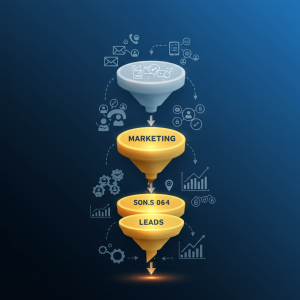Is Outbound Marketing Dead? The Truth About Traditional Marketing

In a world dominated by content marketing, SEO, and social media, you’ve likely heard the bold claim: “Outbound marketing is dead.” Digital marketing evangelists paint a picture where cold calls, direct mail, and TV commercials are relics of a bygone era—ineffective dinosaurs in our hyper-connected, permission-based marketing landscape.
But is this really true? Has outbound marketing truly breathed its last breath?
The short answer: absolutely not.
The longer, more nuanced answer: outbound marketing isn’t dead—it’s evolving, and still plays a crucial role in a comprehensive marketing strategy. Let’s explore why traditional outbound tactics remain relevant and how they can complement your inbound efforts.
What Exactly Is Outbound Marketing?
Before diving deeper, let’s clarify what we mean by outbound marketing. Traditional outbound tactics include:
- Television and radio advertisements
- Cold calling and telemarketing
- Direct mail campaigns
- Print advertising (newspapers, magazines)
- Billboards and outdoor advertising
- Trade shows and events
- Display ads and banner advertising
- Unsolicited email campaigns
The common thread? These methods proactively push messages to audiences, regardless of whether they’re actively seeking information about your products or services.
For a detailed beginner’s overview, see What Is Outbound Marketing? A Comprehensive Guide for Beginners.
Why People Claim Outbound Marketing Is Dead
The “outbound is dead” narrative gained momentum for several compelling reasons:
1. Changing Consumer Behavior
Modern consumers have become adept at filtering out interruptions. They skip TV commercials, use ad blockers, screen calls from unknown numbers, and toss direct mail without a second glance.
2. Cost-Effectiveness Concerns
Traditional outbound tactics often require significant investment with harder-to-measure returns. A single TV commercial can cost tens of thousands to produce and even more to air, with uncertain impact.
3. The Rise of Digital Alternatives
Inbound marketing strategies—content marketing, SEO, social media—often deliver higher engagement rates and more measurable ROI at lower costs.
4. Privacy Regulations and Public Sentiment
Regulations like GDPR and CCPA have restricted certain outbound practices, particularly in email marketing and telemarketing, while public sentiment has shifted against “intrusive” marketing tactics.
Why Outbound Marketing Is Still Very Much Alive
Despite these challenges, outbound marketing continues to thrive for several key reasons:
1. Immediate Visibility and Impact
While inbound strategies may take months to gain traction, outbound tactics can generate immediate visibility. A well-placed billboard, strategic TV spot, or targeted direct mail campaign can create instant brand awareness.
2. Reaching Passive Prospects
Not everyone actively searches for your solution online. Outbound marketing reaches potential customers who don’t yet know they need your product or service.
As Mark Ritson, marketing professor and consultant, notes: “The biggest growth in any category comes not from the heavy category users who already buy your product, but from the light and non-users who currently don’t.”
3. Breaking Through Digital Noise
The digital space has become increasingly crowded. The average person encounters thousands of digital ads daily, creating a new form of clutter. Well-executed outbound marketing can actually stand out more distinctly against this digital background noise.
4. Complementing Inbound Efforts
The most successful marketing strategies integrate both inbound and outbound tactics. A prospect might first encounter your brand through an outbound channel, then engage more deeply through your inbound content.
Modern Outbound Success Stories
Several brands continue to demonstrate the enduring power of outbound marketing:
Apple’s Billboard Campaigns
Apple’s iconic “Shot on iPhone” billboard campaign showcases stunning photography taken with iPhones. These visually striking displays appear in major cities worldwide, reinforcing the brand’s premium positioning and product capabilities.
Super Bowl Commercials
Companies still invest millions in Super Bowl commercial spots because they work. In 2024, brands paid an average of $7 million for 30-second slots—a price they wouldn’t pay without significant returns.
Direct Mail Renaissance
Paradoxically, as digital inbox clutter has increased, physical mailboxes have become less crowded. Brands like Glossier and Warby Parker have embraced high-quality direct mail pieces that stand out and create memorable brand interactions.
How Outbound Marketing Has Evolved

While outbound marketing isn’t dead, it has certainly transformed:
1. Data-Driven Targeting
Modern outbound campaigns leverage sophisticated data analytics to target specific demographics, behaviors, and preferences—making them far more precise than the “spray and pray” approaches of the past.
2. Integration with Digital Components
Smart marketers incorporate digital elements into traditional outbound campaigns—QR codes on direct mail, hashtags in TV commercials, and augmented reality experiences triggered by print ads.
3. Personalization at Scale
Today’s outbound marketing is increasingly personalized. Direct mail pieces can be customized based on previous purchase history, while programmatic TV advertising can deliver different ads to different household demographics.
4. Enhanced Measurement Capabilities
New technologies have made measuring outbound marketing effectiveness more precise. Call tracking, unique URLs, coupon codes, and advanced attribution models connect outbound efforts to tangible results.
When Outbound Marketing Makes Sense
Outbound marketing remains particularly effective in certain scenarios:
1. New Market Entry
When entering a new market where you lack visibility, outbound tactics can quickly establish presence and generate initial awareness.
2. Launch Campaigns
Product launches often benefit from the immediate impact of outbound marketing to generate excitement and momentum.
3. Local Business Promotion
Local businesses can effectively use geographically targeted outbound methods like local radio, community newspapers, and neighborhood direct mail.
4. B2B Complex Sales
In B2B environments with high-value, complex sales cycles, proactive outreach through targeted calls, industry events, and direct mail can initiate valuable relationships.
5. Reaching Specific Demographics
Some demographics remain more responsive to traditional channels. Older consumers, for instance, often engage more with TV, radio, and print than digital-only campaigns.
The New Rules of Outbound Marketing
To succeed with outbound marketing in today’s environment:
1. Be Relevant, Not Just Interruptive
The most effective outbound marketing provides immediate value—entertainment, information, or emotional connection—rather than merely interrupting.
2. Respect Customer Preferences
Provide clear opt-out mechanisms, honor privacy preferences, and follow both legal requirements and ethical best practices.
3. Coordinate with Inbound Efforts
Ensure messaging consistency across all channels, and create clear pathways for customers to transition from outbound touchpoints to deeper engagement through inbound channels.
4. Measure Effectively
Implement tracking mechanisms to understand which outbound tactics drive results, allowing for continuous optimization.
5. Personalize Whenever Possible
Use available data to make outbound communications more relevant and tailored to specific audience segments.
Finding the Right Balance
The most effective marketing strategies don’t pit inbound against outbound but recognize the unique strengths of each approach. Consider:
- Using outbound methods to drive traffic to inbound assets
- Retargeting inbound website visitors with outbound methods
- Testing different channel combinations for various segments
- Applying inbound principles (value, relevance, education) to outbound executions
Conclusion: Evolution, Not Extinction
Outbound marketing hasn’t died—it’s evolved. The organizations seeing the greatest marketing success understand that the question isn’t whether to use inbound or outbound tactics, but how to strategically integrate both approaches to meet customers where they are with relevant, compelling messages.
The future belongs to marketers who can blend the immediacy and reach of outbound approaches with the engagement and measurement capabilities of inbound marketing, creating seamless customer experiences across all touchpoints.
Rather than declaring outbound marketing dead, smart marketers are breathing new life into traditional tactics by making them more targeted, personalized, measurable, and integrated with digital experiences.
In marketing, the most dangerous strategy is dogmatism—rigidly adhering to either an all-inbound or all-outbound approach. The winners in today’s complex marketing landscape are those flexible enough to use the right approach at the right time for the right audience.
So no, outbound marketing isn’t dead. It’s transformed, refined, and—when done well—remains an essential component of a comprehensive marketing strategy.





